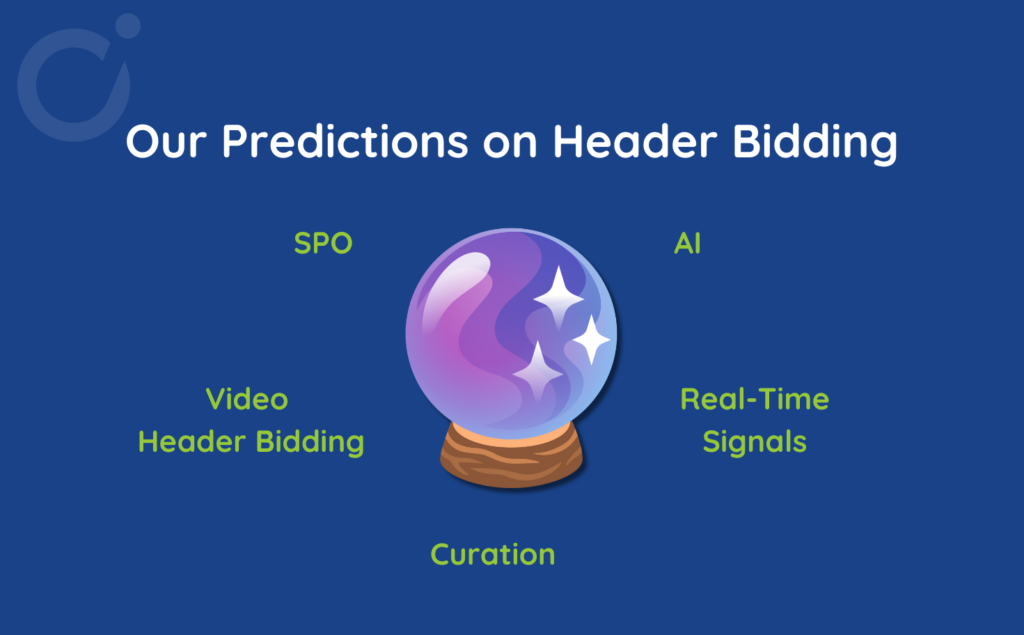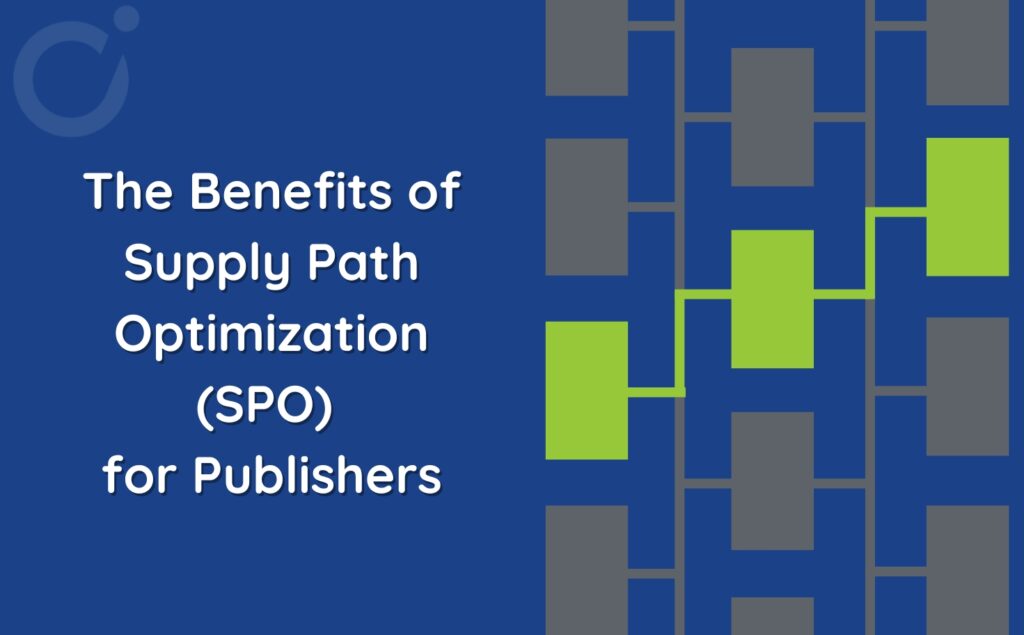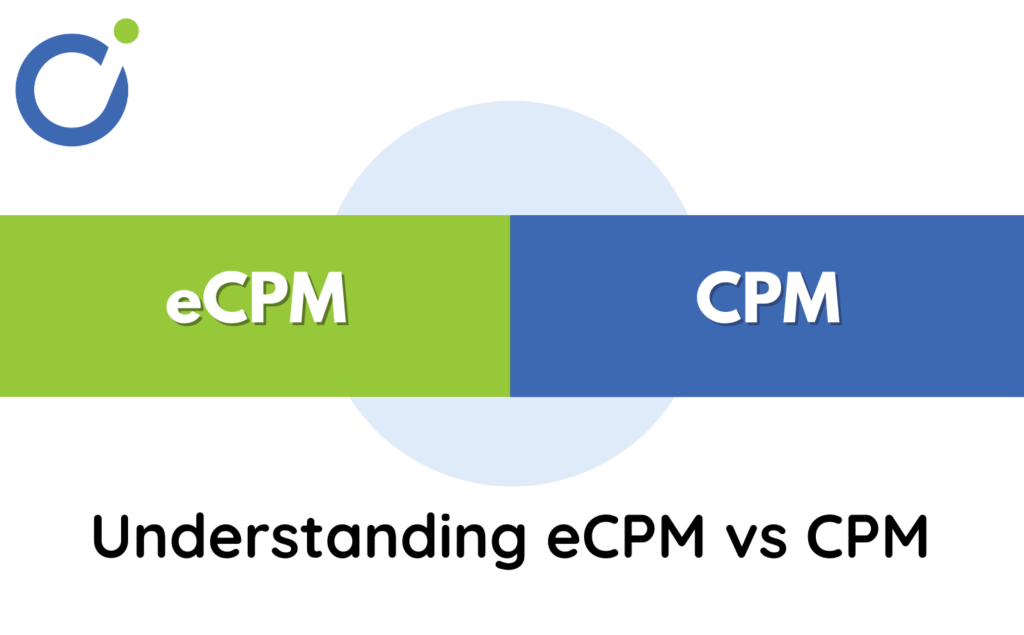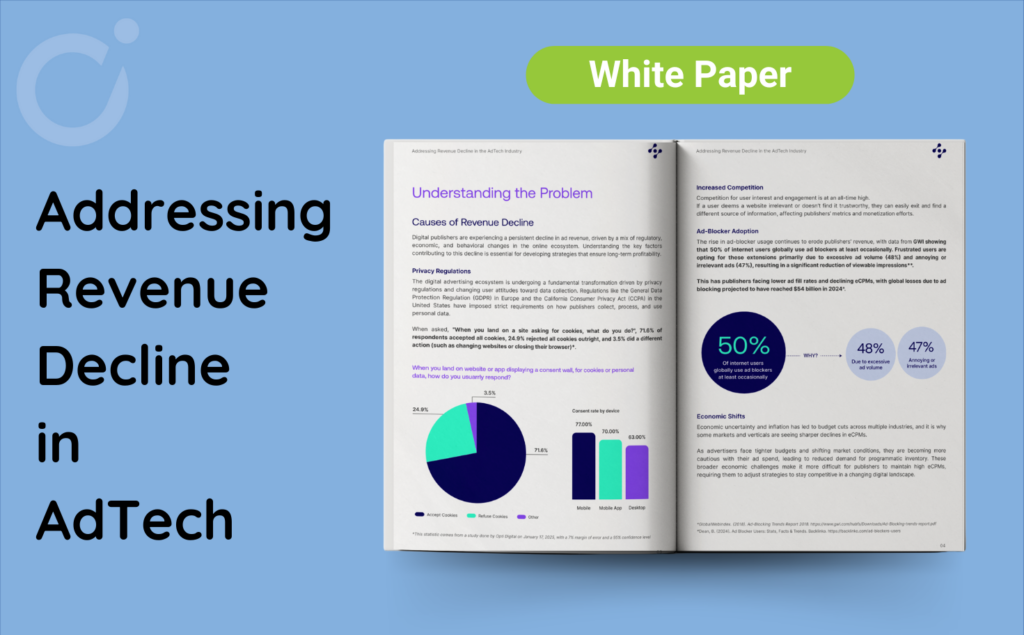ln our fourth and final entry of our header bidding series, we turn our attention to the future of header bidding. As a technique that has already reshaped the programmatic advertising ecosystem by maximizing competition and revenue for publishers, header bidding is now at the forefront of innovation. But what lies ahead? From advancements in artificial intelligence to the rise of video header bidding, the future of header bidding is poised to confront evolving challenges while also unlocking new opportunities. In this article, we’ll explore the history of header bidding, and give our predictions on how emerging trends will impact this innovative technique.
Introduction
Before we turn our attention forward, let’s recap the most important information regarding header bidding.
Header bidding first appeared in the scene in 2014. But the adoption of this technique wasn’t immediate, as several publishers were a bit wary about adopting this new technology. Instead they opted to remain with waterfall bidding, which used to dominate the programmatic advertising landscape.
Waterfall bidding follows a specific structure in which ad impressions are sequentially offered to demand sources based on predefined priority levels, creating a waterfall effect. These demand sources are often ranked by either the average historic yield they have produced for the publisher or their size.
But waterfall bidding brought with it some obstacles, which you can review here.
These obstacles did not allow publishers to maximize their ad revenue, had a negative effect on the user experience, and created even more work for the programmatic team. Overall, it was not the most efficient. It is why header bidding came along as a natural progression.
The Arrival of Header Bidding
Header bidding is an advanced programmatic advertising technique where publishers are able to call on and collect multiple bids from various demand sources such as SSPs and Private Marketplaces simultaneously before their own ad server is called.
To review the step-by-step process behind this technology, take a look at our introductory post here.
To make use of header bidding, publishers must have a JavaScript tag in their website’s header (which is how the name came to be). This piece of code, called a header bidding wrapper, connects the website to various sources interested in buying the ad inventory. Without this code, publishers would have to integrate individual pieces of code in their website’s header for every single bidder that wants to place a bid on the ad inventory.
Client-Side vs Server-Side
There are two main types of header bidding wrappers: server-side and client-side.
Client-Side
Initially, all header bidding was done client-side, meaning the entire process occurred within the browser. As the page loads, it sends bid requests in parallel to various partners, who then submit their bids. The system determines the highest bidder and relays the information to the publisher’s ad server. This approach places the entire burden of handling requests and selecting a winner on the browser, potentially impacting performance.
Server-Side
Rather than relying entirely on the browser, the ad server manages most of the work, including sending bid requests and running the auction. Code in the header signals the server to call bidders and conduct the auction. Once complete, the ad server relays the results to another server, streamlining the process. This shift reduces the browser’s burden while ensuring the rest of the header bidding workflow proceeds seamlessly.
Header bidding has been a revolution in the world of programmatic advertising, ensuring publishers get a fair deal and their ad monetization is maximized. Unlike waterfall biddings, it has enabled a fair and competitive bidding environment, significantly increasing publishers’ ad revenue and revealing new valuable insight into their ad inventory.

The Future of Header Bidding
Now that we have reviewed the most important aspects of header bidding’s history, let’s change scope and take a look ahead. As the programmatic advertising landscape keeps innovating and evolving, header bidding is expected to experience additional changes.
Artificial Intelligence
Header bidding is increasingly working in tandem with artificial intelligence (AI) through machine learning models (ML) to optimize its processes. ML models can process large amounts of data in real-time, allowing for smarter bid optimization.
By integrating ML models into the bidding process, header bidding can further improve the accuracy of bid requests, ensuring that ads are not only highly relevant but also delivered at the right time and to the right person. AI-driven optimizations can also predict the right price for inventory, allowing publishers to adjust their pricing strategies dynamically based on demand.
Furthermore, AI and ML can help detect patterns of ad fraud and provide solutions to mitigate these issues, which have long plagued the programmatic ecosystem, with the total cost of ad fraud in 2022 reaching a staggering $81 billion.
These technologies can identify patterns and behaviours that are abnormal in a manner that is vastly more accurate and time-efficient than manual detection or other previous methods. This can be used to identify fraudulent activities such as bot traffic, click fraud and other forms of ad fraud.
The further blending of Machine Learning with header bidding will lead to smarter, more efficient auctions that benefit all stakeholders.
Video Header Bidding
With video content dominating digital advertising, video header bidding is expected to continue growing in our industry. Video ads require significant bandwidth and specific technical requirements, and as video consumption continues to increase, publishers must ensure they are maximizing revenue from this highly lucrative format.
Implementing video header bidding comes with unique challenges, including the need for more robust infrastructure capable of handling higher data throughput and managing video ad synchronization with the content.
But the benefits certainly outweigh the challenges, as video ads increase in click-through rate to as high as 96%, and are shared 1200% more times than links and text combined. Additionally, viewers retain 95% of a message when they watch it on video, compared to 10% when reading it in a text.
Nonetheless, as more publishers embrace video, the role of video header bidding will only become more critical, offering new opportunities to monetize video inventory more efficiently.

Privacy and Transparency
As data privacy regulations like GDPR and CCPA continue to evolve, data privacy is now at the forefront of many discussions within programmatic advertising. Publishers and advertisers must navigate a complex regulatory landscape while also maintaining user trust.
For header bidding to remain sustainable in a privacy-conscious world, all parties involved must be mindful and transparent about how user data is collected, processed, and shared. First-party cookies are becoming a vital tool due to this, allowing publishers to gather and utilize data directly from their audiences while complying with regulations. Additionally, technologies like unified ID solutions are being developed to complement first-party data, enabling advertisers to identify users without relying on third-party cookies.
Data and Real-Time Signals
There is an overall trend of prioritizing first-party data. In traditional programmatic advertising, DSPs (Demand-Side Platforms) may not always have access to the same level of granular data that publishers do. However, SSPs (Supply-Side Platforms) have access to first-party data, allowing them to create more detailed audience segments. This data can be enriched further by adding contextual information.
Additionally, it is important to highlight that some SSPs detect real-time signals to enrich bid requests, such as the Opti Digital bidder, which filters inventories based on the user’s level of attention and then provides this information to advertisers who can identify qualitative inventory, while the publisher manages to sell it at a fair value.
Curation and Supply Path Optimization (SPO)
Another key trend influencing the future of header bidding is curation. Curation, which refers to the selection of high-quality inventory based on first-party data and real-time signals, is becoming an essential strategy for both publishers and advertisers. In an increasingly complex and privacy-conscious digital ecosystem, curation is emerging as a powerful tool to enhance the efficiency and relevance of ad transactions.
The concept of curation is highly complementary to header bidding, particularly in its ability to improve ad targeting. Header bidding, by allowing multiple demand partners to bid on ad space simultaneously, opens the door for more competitive auctions, driving up publisher’s ad revenue. But the future of header bidding isn’t just keeping this increased competition; it’s also about enhancing the relevance of bids and ensuring that ads are well-matched to their intended audiences.
Curated inventory Increases interest from advertisers to acquire publishers’ premium ad space based on more refined audience insights.
Curation goes hand in hand with Supply Path Optimization (SPO). SPO is about ensuring that ad inventory flows through the most efficient and cost-effective paths, minimizing the number of intermediaries between publishers and advertisers. Curation naturally aligns with SPO, as both aim to streamline the supply chain and reduce unnecessary costs.
By focusing on curated inventory, publishers can optimize their SSP partnerships and reduce inefficiencies in the bidding process. Curation allows them to maintain strong relationships with the most valuable demand sources while ensuring that ad space is sold through the most profitable routes. This helps publishers avoid overpaying for intermediaries and ensures that they are getting the best possible price for their inventory.
Conclusion
Header bidding has come a long way since its inception, evolving from a novel workaround to the standard for maximizing ad revenue in programmatic advertising.
Looking to the future, the integration of AI and machine learning, the rise of video header bidding, the growing focus on privacy and transparency, and curation will shape the next generation of header bidding.
By embracing innovation and transparency, header bidding will continue to play a central role in programmatic advertising for years to come. As publishers navigate this new era, those who stay ahead of the curve will be well-positioned to thrive in the competitive digital advertising landscape.
Don’t hesitate to get in touch with us if you would like to make sure that your ad stack remains competitive amongst all the innovations in our industry.







